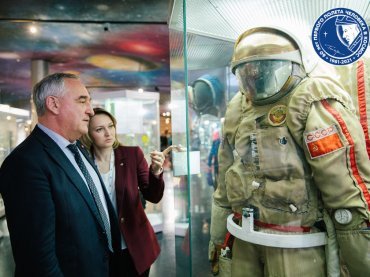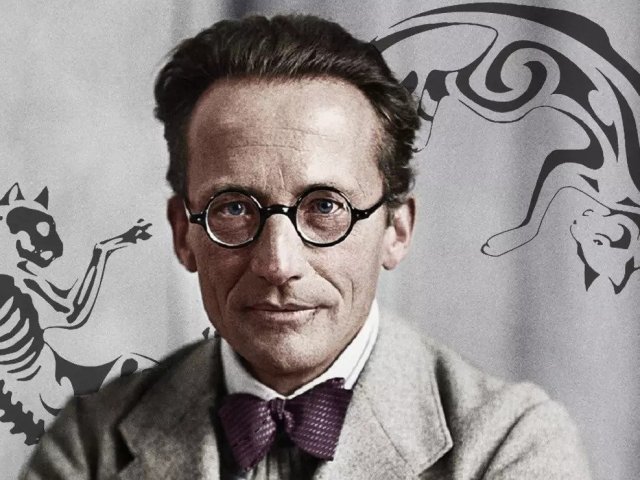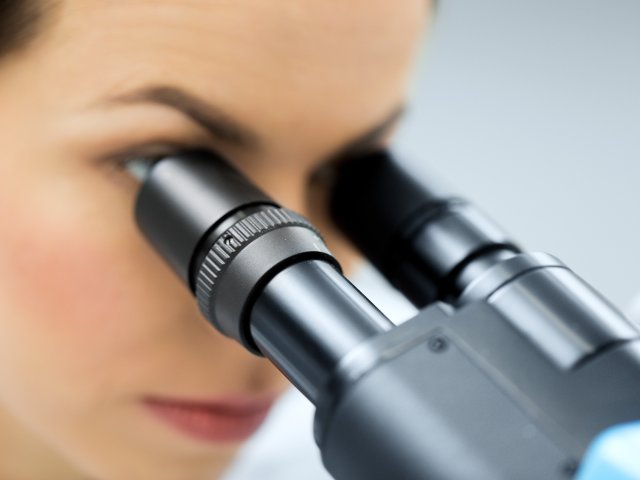The 60th anniversary of the first manned space flight. A true milestone event for Russia and the world. It was the space flight of Yuri Alekseevich Gagarin that marked the start of space research. Soviet scientists began their confident progress in space exploration. At present, the International Space Station brings together 14 countries that cooperate on the orbit and conduct scientific experiments. Scientific Russia has discussed how those experiments are conducted and what kind of work cosmonauts do during space flights with Yelena Vladimirovna Popova, Candidate of Pedagogical Sciences, Head of the Unit of Cosmonaut Training under the scientific program of Yuri Gagarin Cosmonaut Training Center, and Aleksandr Aleksandrovich Skvortsov, Class 1 space pilot, Hero of the Russian Federation, Leader of the Cosmonaut Candidate Group at Roscosmos.
- Aleksandr Aleksandrovich, what is space to you? Becoming a cosmonaut must have been your dream as a boy, as it was for many kids?
Aleksandr Skvortsov: – Yes, everyone dreamt of it back then. My younger brother was named after Yuri Alekseevich Gagarin. Space was my dream. I can’t imagine how many events have to form into a chain for that. Everyone has their own path to space. One has to be in the right place at the right time, and be in sufficiently good health. It was also the power of a dream and the words I said once in the presence of a pilot: “I’d like to try and become a cosmonaut. I would like it so much.” It worked. Because he knew they were recruiting to the Cosmonaut Squad, and he told me: “Listen, there is a recruiting campaign for the squad right now.” So, I filed my application and was selected for the squad in the recruiting campaign of 1997 – among 8 out of 320 military pilots who took part in the selection. And my health happened to meet of the requirements.
- Yelena Vladimirovna, how cosmonauts are trained?
Yelena Popova: – There are several phases in the cosmonaut training. Phase 1 is the general space training, where general, basic aspects of cosmonaut training are discussed. For instance, regarding the science program, the training covers experiments and science disciplines that a cosmonaut has to know to complete the flight program in the future. Phase 2 involves group training, which is more advanced and practical. This phase involves theory and practice, with the trainees learning their profession on a more advanced level, with the use of special equipment and from a technical viewpoint. Phase 3 is the crew training phase, where the trainees perform tasks within their flight program.
Aleksandr Skvortsov: – I joined as a fighter pilot. To me, the first exam at the general space training under a science program was most unusual. During one of the classes for flights to the then Mir station, my assignment was to inseminate newts. There was a scientific experiment there. The science training was a constant source of discoveries for me. You come to understand eventually that you are going to need those things. So, the attitude was very serious. You don’t know what’s in store for you, but you understand you have to be ready for anything. The newts were a start. Later on, I saw multiple times that the diverse training was bringing good results.
- Yelena Vladimirovna, what criteria are used to determine if cosmonauts are ready for space flights?
Yelena Popova: – One of the most important criteria is the pre-flight test for the crew. One of the most important procedures is the assessment of all skills cosmonauts learned during the training. All cosmonaut’s activities are assessed by a large qualification commission. The crew work on the training mockup facility of the International Space Station Russian Segment (ISS RS) for an entire day, practicing the flight program prepared for the test. The second test takes place on Soyuz mockup facilities, where cosmonauts also spend a day practicing the entire program the commission would approve. The crew receives the test program by picking one of the examination cards at random. The commission watches the crew working at our “improvised flight control center”; the crew’s performance is then discussed and scores are awarded.
Aleksandr Skvortsov: – The thing is that many experiments performed in space should be better adapted to zero gravity conditions, and some experiments are easier to do in zero gravity. During a standard 24-hour test, the grand commission watches how you perform those experiments and awards performance scores. Of course, we try to find a more comfortable place, but sometimes you have to stand on one leg, hold a camera on your shoulder, etc. It's a bit easier in zero gravity. It’s in zero gravity that we run experiments and produce results. Nobody can see how you do it. You have to be creative.
- In space, do you perform several tasks at the same time?
Aleksandr Skvortsov: – Each crew knows the set of experiments to be performed. That’s why the general space training comes first, followed by the group training – those parts are more theoretical and broad. When you come to work with the crew, you train specifically for your scientific program. The number of experiments assigned to the crew for the flight varies every time. But this also depends on the workload, other tasks the crew would have to complete, such as spacewalks and other things. I wouldn’t like to see the science program take a backseat, because, at the end of the day, the primary job, while in space, is actually to run as many scientific “payload” experiments as possible. You understand that you did not just fly to space, but you maintained the operable condition of the station but, most importantly, you have brought some useful scientific results from the orbit. This is every cosmonaut’s goal.
- Yelena Vladimirovna, aside from cosmonaut training, the Center is doing aerospace research to study the Earth’s natural resources. How is it done from space?
Yelena Popova: – We have a scientific area: studying Earth from space. Activities in this area involve studies of natural resources and disasters that manifest themselves on Earth. This activity area includes research of physical phenomena that have a significant impact on the global climate and environment, observation of the state of dry land, oceans and atmosphere, and monitoring of the geophysical parameters of the natural environment. A cosmonaut has high-resolution cameras onboard, enabling them to observe our Earth. While onboard, the cosmonaut receives fixed assignments that specify when, at what time, and what object is to be photographed. The cosmonaut takes photographs, sends them to Earth, and then scientists examine and decode the data.
- Aleksandr Aleksandrovich, were you nervous while preparing for your first flight? What did you feel when you were in space for the first time?
Aleksandr Skvortsov: – I was both nervous and scared. But it was rather because of the responsibility that I had to bear, since no one in the crew that went to space then, i.e., myself, Mikhail Kornienko, and Tracy Caldwell Dyson, knew who and how was going to respond to zero gravity. It’s one thing to prepare for it on Earth. Each person’s body responds in its own way. When you float into the station, it gets a bit easier. You understand that there is someone else there, who can support you, because there is a crew there as well, which will always give you some tips or explain something to you. But I think we did it and things worked out fine. The second and the third flights were clear to me, as I knew myself and knew how I was going to act. That is why I only could help someone else. What I felt then was not fear, but anxiety and responsibility for what was assigned to me. Everything was great in my three flights.
- Yelena Vladimirovna, what products are being introduced now for space research?
Yelena Popova: – There is a number of quite interesting space experiments that are laying the groundwork for the future and supporting development of space exploration. One of the most impressive experiments was Kontur-2, when cosmonauts controlled a land robot from onboard the space station. There were two robots: one in Germany and one in Saint Petersburg, Russia, which were used to practice remotely controlling a robot located on Earth. Such projects are tests for the future remote control of robots placed on the Moon or on distant planets.
Another experiment is 3D-Bioprinter, osteochondral tissue cells were grown on a bioprinter. Aleksandr Aleksandrovich was doing that during his flight. Later, muscular tissue cells of various animals were grown as well. 3D-printing of organs and tissue, including chondral tissue, is developing rapidly. But so far, there have been just a few research works on creating bioengineered chondral tissue on the orbit, which used animal cells. The experiment has been suspended for a while, but we expect it to be resumed.
If we look at each scientific area – we have six – there are experiments that are already aimed at further space exploration. Today, there is a large number of experiments that “beat the path” to the Moon program. One of those is the Bio-Degradation experiment, set up by the Moscow State University. What makes it interesting is its significant scientific groundwork for all its simplicity – the scientists are investigating how much damage microorganisms do to the station walls. There are some conceptual-level projects, but I don't want to reveal the scientists’ secrets. There are projects that will ensure the quality maintenance of the station, namely, of the walls inside it.
Another experiment we could talk about is the Test experiment. It was performed to investigate the possibility of there being live cells on the outer surface of the station. Surprisingly, with the temperatures and the radiation being what they were, surviving microorganisms were found there.
I have to mention another experiment that is being prepared and will be performed by the Cosmonaut Training Center jointly with Belgorod University – the Protection Composite experiment, which is also to be used during the flight on the ISS and future flights. A material has been designed to protect the crew from radiation. This is a very important experiment since we know that the background radiation in space is quite high. If we were to fly to the Moon, the radiation there would be even higher. Therefore, we are already starting to think how to protect cosmonauts from radiation during long-distance space exploration flights. The experiment is being developed. If things go according to our plan, we’ll hear of it in a year.
- Aleksandr Aleksandrovich, you said that cosmonauts had their favorite experiments. What do you like in particular?
Aleksandr Skvortsov: – There were such experiments, of course. First of all, they were run for the first time. Yelena Vladimirovna was talking about robots and remote robot control from space. When I first worked with the robot Fedor, the Soyuz spaceship that delivered it could not dock in the beginning. It only happened two days later. The problem was that it had to return on time, and we had less time for all our work with it, while the tasks remained the same. We had to improvise, trying to catch up with the work schedule. I’ll remember that experiment for a long time. For all the efforts, the result of our work with the robot is promising. We are going to work in this area, and I think this will make open space work less labor-intensive for the crew. Cosmonauts would no longer have to go into the outer space; they would just use a robot placed on the station surface. That would also mean reduced exposure to radiation, radiation being a major issue associated with people’s presence in space. Therefore, our stay at the station now is also limited by our exposure to certain doses of radiation. It's no secret that the longer you fly the more radiation you receive.
Scientific Russia portal thanks the Yuri Gagarin Museum for assistance with the interview.
Interviewer: Anna Posokhova
Беседовала Анна Посохова.






















